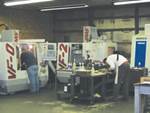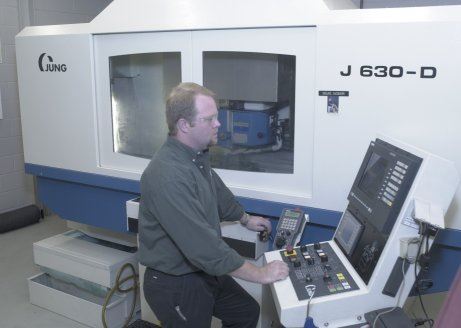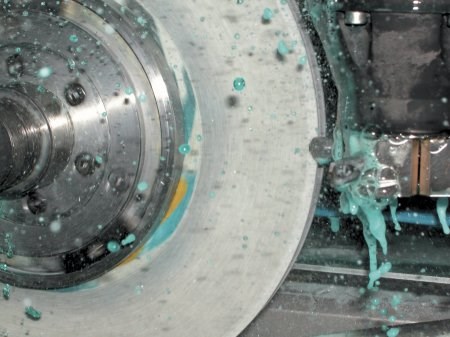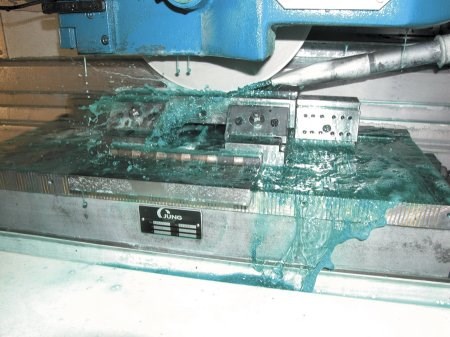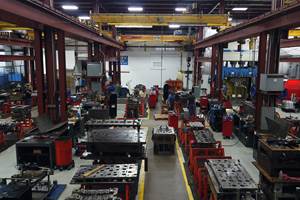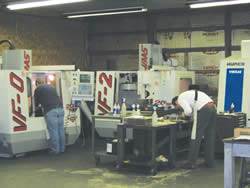Technology and Skill Are Keys to Mold Shop Success
In a driven and changing mold industry, a secret weapon has helped one mold shop to excel and grow.
As one of three manufacturing companies under Laitram LLC, Intralox, Inc. (New Orleans, LA) reigns as the inventor of and world leader in modular plastic conveyor belts. With more than four hundred combinations of belt styles, materials and colors to offer, the company easily keeps its in-house mold-shop running at full capacity. Today, with twenty-nine highly skilled moldmakers and repair technicians employing nine surface grinders, five milling machines, three sinker and two wire EDM machines, the Intralox mold shop may well be one of the most competitive shops in the region. A particularly competitive weapon is its new Jung J630-D with a PA/31 contour dresser with four diamond stations from United Grinding Technologies (Miamisburg, OH)—a company providing grinding mchines worldwide.
A Look Back
According to Jules Ceccanti—mold shop manager—Intralox started out ten years ago as a mold repair facility. Then, as the repair activity continued, the decision was made to begin building mold cavities. As that capability grew, the company invested in more and new technology; today, the mold shop is the predominant supplier of plastic injection molding tooling.
The reason that Intralox has its own mold shop is evident—the competitive advantage of time-to-market, plus the confidence that comes from complete process control and consistent product quality, as well as being able to capture the sensitive issue of the retention of proprietary mold information. "If Intralox wanted to outsource its mold work," Ceccanti says, "it would be looking at eighteen- to twenty-week leadtimes. Here, we can have a mold done and be producing good parts in six weeks, when we have to."
The shop does outsource some mold work, but some jobs have proven just too tough for others to tackle. "We used to bid out a couple of parts that we do very efficiently now on the Jung J630-D," Ceccanti says. "These parts are very complicated, highly detailed, time-consuming and very close-tolerance. Some shops just refused to quote; others bid high because they were either unsure if they could even make the part, or unsure whether they could make a profit on the job. There were two of these parts, Ceccanti says, that got bids of $1,750 per part. With the Jung, his team makes the parts for $400 each.
Technology Matters
Shane Jackson—lead moldmaker—addresses some of the reasons the J630-D was acquired. "Our previous CNC machine," he says, "could do just about everything we wanted, but there were some limitations. The diamond dressers were stationary, which meant the machine had to travel X, Y and Z to the dress wheel, which tended to create flat spots—spots where parts of the diamond surface are worn more than others. When we'd start getting spotty diamond wear, the machine operator would try to compensate for the wear, but the compensation just wasn't accurate enough."
The CNC dresser on the Jung rotates about an axis and permits much more controlled diamond wear. Further, if a certain section of the diamond begins to wear, Jackson says, you can change the angle where the diamond and the wheel intersect, thus avoiding the worn section and using more of the diamond. The rotational four-diamond dresser avoids diamond wear and, importantly, the Jung permits continuous dressing so that dressing and grinding can occur simultaneously.
Jackson says that with the previous method, he'd have to draw all the wheel geometry, then post it through a software program, Mastercam, and then download it to the machine. With the Jung, however, he simply takes a DXF file from the designer, plugs it into the J630-D and runs the wheel profile right from the file. "Transferring information is so easy," he says. "You go straight from DXF files as opposed to built-in macros and a catalogue of shapes on other machines. It's fast, straightforward, slick."
A resident wheel library facilitates quick setup. Jackson explains that the Jung actually "remembers" wheel shapes. "You can take the wheel off and store it away, but the wheel information stays in the machine's library. When you put the wheel back on, you type in a library number, and the Jung knows what the wheel shape was the last time it was used. This is a great feature, permitting the flexibility to interrupt a job, run a new job or several jobs, and then go back to the original job with no complicated reprogramming or setup issues—even if a month has passed between jobs."
A Look at Mold Work
Jackson says that the Jung is used for the most critical work—tough materials with very tight tolerances and requiring superior surface finishes. For example, special core pin slots, which are roughly 0.2000" deep x 0.4000" wide x 12" long in a cavity block that's 12" x 12" and 2" thick. Typical material is 420 stainless or ELMAX, a powder metallurgical high vanadium version of 420 that's comparable to D2, and one of the most difficult materials to grind. 420 is generally 50-52 RC and ELMAX is 58-62 RC. Once a cavity block has been squared up and sized, it will come to the Jung where Jackson will load the wheel geometry, radii and angles, wheel manufacturer, wheel type, grit size, etc. into the wheel library. He's then ready to dress the form.
"After I've dressed the form," Jackson says, "I'll qualify it by grinding the form in graphite. Then I'll pull the graphite and inspect it using conventional means, comparators, indicators or a Zeiss CMM to inspect and check the contour or axis of the radius. Generally, on forms we hold q0.0002". If the graphite checks out, I know the wheel geometry is fine. Then, I'll touch on either side of the block, find the center, calculate my locations—typically programming to location and depth—and then run the part. The part is already right on size, without running any test work."
Jackson explains that in his experience with other grinders and dressing systems, he's never been able to set up quickly and run a part on the first pass without grinding to a certain depth, taking the part out and checking again before grinding further. "Typically, in moldmaking, you cut some and then you measure; then you cut some more and measure again," he says. "As you get closer and closer to your final dimensions, you're measuring more and cutting less. With the Jung, once the wheel geometry is correct, you measure once and cut straight to dimension."
The result is a significant savings in time, as well as an increase in productivity and flexibility. Jackson cites a couple of examples: before the Jung, it would take a full day to run four to five typical 8" x 10" cavities with four core slots. With the Jung, he can set up the same job and run production—all before noon. "Start to finish, it would take us two full ten-hour days to run six cavities before the Jung. Now six cavities are done in a day," Jackson says. "That's a time savings of 50 percent, and it's not that the Jung grinds any faster, it's in setup time and measuring time where we see the real competitive benefits."
Confidence in Your Machines
Jackson says that one of the crucial issues in mold work is having complete confidence your tools—especially your grinder. "You have to build a level of trust in the machine," he says. "Manual machines, for example, are notorious for creeping, getting a lot of wheel wear and not knowing exactly where the wear is."However, he says he doesn't have to worry at all with the J630-D and its rotating four-diamond dresser. The way PA/31 works, Jackson says, is that the unit rotates through each of the four diamonds—a rough diamond, a semi-rough diamond, a finish diamond and an idle diamond. The idle diamond takes a zero pass all the way through the form, ensuring that if any flat spots remained after the three previous passes, the idle diamond will pick them up. "This kind of system builds confidence and a comfort zone," Jackson says. "I can make very, very accurate parts."
Competing and Facing Change
Ceccanti says, "Once, moldmakers were guys with a file who could make a mold out of very simple tools and instruments. They were masters of many things—they could mill, drill, grind and weld. They could do it all." But the industry has changed. Today, to compete moldmakers need to use very specialized machines that provide high productivity and flawless accuracy. Though, the moldmaker is no longer a jack-of-all-trades, he has to be able to adjust, run and maintain highly technical machinery. Successful mold shops, Ceccanti explains, have to be able to convert their operations to high-end, high-productivity and high-accuracy technology.
This situation drives two issues: 1) management needs to recognize that it must invest in operator training and simultaneously try to recruit moldmakers who can step into this rapidly changing industry and 2) moldmakers are challenged to recognize that things are indeed changing and the way for them to survive is to embrace new technologies and methods.
"The challenge for mold shops in the future is to invest in new technology and the people to run it," Cecannti says. "This Jung machine, for example, was several notches more expensive than other similar CNC grinders. But we're getting more than our money's worth. In the mold business, you can't afford to buy capital equipment on price alone. You have to consider quality, capability and reputation. Staying competitive in this business is providing high-tech tools to highly skilled moldmakers."
Related Content
Precision Meets Innovation at IMTS 2024
After attending IMTS, it's clear that the integration of advanced technologies is ready to enhance precision, efficiency and automation in mold manufacturing processes. It’s a massive event, so here’s a glimpse of what the MMT team experienced firsthand.
Read MoreVIDEO: Maintaining a Customer-Centric Culture
Progressive Components President Glenn Starkey talks about the importance of the customer and culture when developing technology solutions for the moldmaking industry.
Read MoreFour Micro Tooling Considerations
Issues involving gating, ejection, mold splits and direction of pull are of special concern when it comes to micro tooling.
Read MoreIndiana Mold Builder Decatur Mold Offers a History of Grit and a Future of Innovation
Decatur Mold Tool and Engineering Inc. serves as a tooling tour guide, helping busy tooling managers reduce uncertainty, lighten workload.
Read MoreRead Next
Berrien Tool Coalition: A Marketing Edge
This group of companies delivers a full-systems approach to manufacturing—art to part and every-thing in between.
Read MoreReasons to Use Fiber Lasers for Mold Cleaning
Fiber lasers offer a simplicity, speed, control and portability, minimizing mold cleaning risks.
Read MoreHow to Use Continuing Education to Remain Competitive in Moldmaking
Continued training helps moldmakers make tooling decisions and properly use the latest cutting tool to efficiently machine high-quality molds.
Read More
